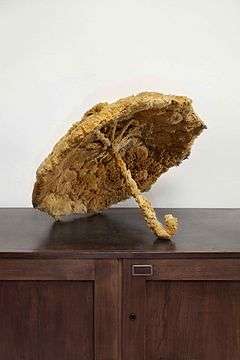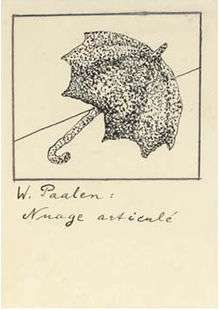Nuage articulé

Nuage articulé (Articulated cloud) is a surrealist object in the form of an assemblage by Wolfgang Paalen produced in 1937. The object consists of an umbrella covered with natural sponges and was one of the most significant objects at the Exposition Internationale du Surréalisme, which was held in Paris at the Wildenstein Gallery in 1938. It was also exhibited in numerous later exhibitions, such as Amsterdam (1938), Cambridge (1938) and Mexico City (1940). Many photographers have captured the item in its context, Man Ray, Kurt Husnik, Josef Breitenbach and Denise Bellon.
Description
The object consists of a standard black umbrella covered with flat-cut, dry natural sponges which are glued onto the fabric surfaces, the clamp and handle of the umbrella. The dimensions are 66 x 94 cm.
History
The original definition of the surrealist object art comes from the French poet Comte de Lautréamont. In his poem Les Chants de Maldoror he describes the beauty of the young man Mervyn using antipodal metaphors: "He is as beautiful (..) as the chance encounter of a sewing machine and an umbrella on a dissecting table". In 1937 the French editor Gallimard prepared the publication of the collected works of Lautréamont in an illustrated luxury edition, and André Breton invited besides other artists also Paalen to contribute with an illustration Breton selected (from two proposals) the drawing Vieil océan (old Ocean), which was published in the Gallimard edition next to the appropriate text.[1] The umbrella was always a strong metaphor in the imagery of surrealism: After a rainy day in the year 1930, he ran as congenial symbol of masculine-surrealist fury for many years – in front of a cinema André Breton had torn an umbrella from the hand of a smaller passer-by, because he had nearly hit the great Breton in his eyes. The poet broke the umbrella over his knee, which the friends Desnos, Prévert, Tanguy, Péret and Duhamel imitated, to do the same with other passers-by. The subsequent turmoil created the typical group euphoria which generated the emotional satisfaction that Breton was a matter of the heart.

In the autumn of 1937, Breton began "during dinner-meetings with a limited number of participants after or before the usual meetings"[2] to exchange opinions and suggestions on the proposed Exposition Internationale du Surréalisme, as well as to prepare the catalogue. Although Paalen was helped by his sister-in-law Geo Dupin at work, Nuage articulé was not ready prior to printing of the catalogue Dictionnaire abrégé you surréalisme; Breton, who particularly liked the object, published a project-drawing of Paalen. Whether Paalen brought the half-finished screen to a discrete private meeting in a smaller circle or just told the friends of it we do not know. Even the mere possibility, Paalen would eroticize the reality of the umbrella dialectically, will have certainly caused a stir, and as it was abundantly clear that a male-female union would be carried out here, all eyes were on reception. The umbrella as such embodied apart from its obvious phallic meaning, a masculine mean against the perils of nature and existence and was suddenly on everyone's lips. Paalen's proposal of a physical feminization was initially almost overlooked – the sponge cover feeds in moisture, has cleaned and touched naked woman's skin and still remained nature, and the opening of the sponge screen was suddenly the calyx as fertilizing stamen. The screen, however, was felt in the surrealist context primarily as a symbolic threat against bad weather. Marcel Duchamp's friend Henri-Pierre Roché reported that Duchamp was once asked by Breton, "to create a new ceiling for the large main room of the exhibition", and had the spontaneous idea, "to cover it with hundreds of open umbrellas with their tops down".[3] It became only clear at the last moment, that it would be impossible to find that many umbrellas in the short term. Duchamp borrowed an open coal stove and a whole truckload of used coal-sacks from a coal merchant from La Villette, which he filled with newspaper and hung over the coal stove instead of the umbrellas.[4]
Reception
The erotic connotations of Nuage articulé, with its umbrella covered with natural sponges, embodied a dynamic sense of contradiction: bloom with stalk; sponge as symbol of nature, as a feminine utensil, which touched and cleaned naked female skin; umbrella as a masculine symbol of order and protection from natural forces. It thus became widely recognized among the Surrealists and their growing public. Geo Dupin, Paalen´s sister-in-law, remembered that Alfred H. Barr, Jr. had been extremely taken with Paalen's object and had chosen not to buy it, for the Museum of Modern Art in New York, only because it was too fragile and difficult to transport.[5] Nuage articulé was published later in a more political context in the Surrealist magazine London Bulletin, together with a text by André Breton translated by Samuel Beckett with acomment that the sponge-umbrella would bring to mind another, sadly prominent, umbrella-that of Neville Chamberlain at the 1938 Munich Conference and the failure of the British policy of appeasement.[6]
Versions and presentation
In 1938, the object was presented mostly hanging from the ceiling, 1940 Paalen opted for a museum-like presentation on a pedestal. Two versions have been preserved: Nuage articulé was kept by Geo Dupin and sold in the 1970s to the Moderna Museet, Stockholm, bought by the Swedish art historian Pontus Hultén, where it is still visible today. Nuage articulé II was executed by Paalen for the International Surrealist Exhibition in Mexico City in 1940, as due to the war objects from Paris could not be shipped. It was kept by Ines Amor, the owner of the Galeria de Arte Mexicano, who had organized the exhibition in 1940, and is now in a private collection in Berlin. It was exhibited recently several times: 2011 in the Schirn Kunsthalle, Frankfurt (exhibition Surreale Dinge),[7] 2012 in the Mjellby Konstmuseum, Halmstad (exhibition Surrealistiska ting)[8] and 2013 in the Centre Pompidou, Paris (exhibition Le surréalisme et l'objet)[9]
References
- ↑ Comte de Lautréamont: Oeuvres complètes, Paris 1938, p. 24
- ↑ Georges Hugnet: Pleins et déliés, La Chapelle sur Loire 1972, p. 39
- ↑ Henri-Pierre Roché, Souvenirs of Marcel Duchamp, in Robert Lebel. Marcel Duchamp, Cologne 1959: p. 84
- ↑ Who originally had idea to the umbrella will not be cleared exhaustively, although it remains doubtful whether Paalen would have put so much effort into making his screen when it would have been clear from the beginning that this would otherwise hang with hundreds on the ceiling. Nuage articulé then hang from the ceiling of the rear side room where also stood Paalen's object Potènce avec paratonnèrre (gallows with lightning rods). See Annabelle Goergen, Exposition internationale du Surréalisme Paris 1938 , Munich 2008, p. 130f.
- ↑ Andreas Neufert, Conversations with Geo Dupin, Paris 1987, see also Neufert (2014), p. 300ff.
- ↑ Mesens, E. L. T., (ed), London Bulletin (Feb. 1939), No. 10
- ↑ Ingrid Pfeiffer und Max Hollein (ed.), Surreale Dinge, Skulpturen und Objekte von Dalí bis Max Ernst, Frankfurt 2011, p. 262f., reproduced p. 210f.
- ↑ Karolina Peterson (ed.), Surrealistiska ting, Halmstad 2012, p. 24 (repr.)
- ↑ Didier Ottinger (ed.), Dictionnaire de l'objet surréaliste, Paris (Gallimard) 2013, reproduced p. 202
External links
- Nuage articulé I im Moderna Museet, Stockholm
- Nuage articulé II in der Schirn Kunsthalle Frankfurt
- Nuage articulé II im Centre Pompidou 2013